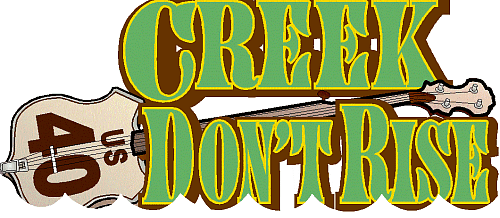



|
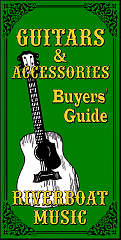
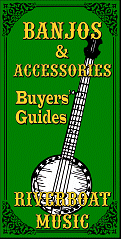
| Written by Paul Race for Creek Don't Rise? |
5th String Capos and Spikes
The "Fifth String" on your banjo (counting from your toes up) is intended to play the same note most of the time. This is called a "drone string," and is a carryover from African gourd instruments that were the banjo's ancestors.Not that "drone strings" are unique to banjos - they've also been used on Appalachian dulcimers, hurdy-gurdies, and countless ancient and medieval instruments.
Generally, drone strings are used in instruments that will be played in only one or two keys. Since the banjo is most often played in the keys of C or G, having a drone string that plays a high G note constantly is usually not a problem. In fact G sounds good in most chords you're likely to play in either of those keys. (Especially since most 5-string players substitute D7sus4 for D7 most of the time.)
But other keys can get a little more complicated. If your partner in crime is a guitar player who wants to play a song in D, you can either play D, A, and G chords in root position or capo the first four strings of your guitar up two frets. But the 5th string can't keep playing high G. Many banjo players will simply tune the 5th string up to A, then tune it back down to G for songs in C or G. All of this tuning up and down will take a toll on your 5th string, but you should have a spare in your banjo case at all times anyway.
But what if the next song is in Bb? You can easily capo the first four strings of your banjo up three frets, but the G note doesn't go with Bb. You could tune it down to F, but it would lose some of its "zing." You could tune it up to Bb, but you would run a risk of putting your eye out.
To avoid having to retune the 5th string too much or two often, banjo players and luthiers have created a number of solutions, including:
- 5th-string capos - devices that allow you to raise the pitch of your banjo's 5th string the same way a regular capo allows you to raise the pitch of the other four strings.
- "Spikes," sometimes called "Railroad Spikes" - tiny L-shaped pieces of metal wire that you can hook the 5th string under to temporarily fret it higher up the neck.
We'll look at some of the capo technologies and "spiking," and then take a look at which 5th-string notes sound the best on the most common keys.
Rail-and-Slider Capos
Many pickers whose bands change keys a lot, especially mid-song, consider the sliding "capo" to be the most convenient option. This consists of a long bar that you attach with screws to the neck of your banjo, as well as a little sliding bit that frets the string wherever you move it.

The photo above shows a Shubb capo attached to a Goodtime neck. Shubb is by far the most popular manufacturer of this style capo, though I remember seeing similarly designed capos years before Schubb's came out. You can see that the capo can be slid almost instantly to fret the fifth string at the 6th, 7th, 8th, 9th, or 10th fret allowing you to raise the fifth string to Ab (G#), A, Bb, C, C#, or D. When not needed it can easily skootch back over the fifth fret.
To some folks, drilling holes in the neck of professional banjo is anathema. But to actual pros who use their banjos as "tools of the trade" that's not necessarily a problem. For the most part, applying a sliding capo won't damage the value of a pro banjo to anyone but a collector (most of whom don't actually play anyway).
The same pros appreciate the ability to jump from playing in G to A to Bb almost instantaneously. Such key changes are not only popular in "pop" music, but also in "Country Rock," "Southern Rock," "Newgrass," and mainstream Country.
That said, if you tend to perform with folks who mostly stay in the same keys, this product may be overkill. Some folks also say it gets in the way when they're doing fancy picking up the neck. Not to mention that they're not quickly moved from one banjo to the next.
Advantages include:
- It's permanent as long as you leave it on your banjo - friends can't borrow it and forget to return it, and it can't get lost in your gig bag or left in your practice nook.
- Changing notes is almost instantaneous - many folks can do it in the middle of a beat.
Disadvantages include:
- If you go back and forth between banjos, you might have to install one on each banjo you use.
- Some folks say it interferes with their left hand when they're playing on the high frets. (Some folks say it's not a problem.)
- Some folks get queasy about mods to their banjos. Note: If you're really gigging night after night with a band that plays in goofy keys, you'll get over this in a hurry.
Final Notes:
- The people who are happiest with this are either:
- Those who paid a professional to install it.
- Folks like me who refurb or reconfigure their banjos (even their pro banjos) on a regular basis to meet their needs and are prepared for things NOT to work according to the instructions.
- Conversely, the folks who are least happy with this are folks who barely know their way around a workshop who think "how hard could this be?," butcher a collector's item or heirloom instrument, and get bad results because they installed it a 16" too high or too low.
Shubb's original offering was much longer than their current offering allowing you to go beyond the 12th fret on some banjos. However, users complained that the thing got in their way when playing up the neck, and they never needed it to go past the 10th fret anyway.
The current 6" version seems to be a better choice for most folks who don't need to capo the fifth string past the tenth fret. It's shorter and only takes two screws to install.
Ignore the wires wrapped around the ends in the photos below. That's just how it's packaged - it's attached by little screws.
 Though this isn't a catalog page per se, I'm posting the Amazon link if you want to check it out online. If you've been reading my pages a while, you've noticed that - even though I might get a small commission on anything I send you to - I only like to the products I can actually recommend from a company I more-or-less trust to get it to you.
Though this isn't a catalog page per se, I'm posting the Amazon link if you want to check it out online. If you've been reading my pages a while, you've noticed that - even though I might get a small commission on anything I send you to - I only like to the products I can actually recommend from a company I more-or-less trust to get it to you.

 The longer version can still be ordered for folks who are afraid they might find themselves playing in the key of F# or otherwise need extraordinary pitches on the 5th string. One reader whose lead singer likes to jump up a half step on every verse of the song finds it especially helpful, since he can just keep going all the way up the neck. Again, I will provide the link to the Amazon page for this, in case you want to try one.
The longer version can still be ordered for folks who are afraid they might find themselves playing in the key of F# or otherwise need extraordinary pitches on the 5th string. One reader whose lead singer likes to jump up a half step on every verse of the song finds it especially helpful, since he can just keep going all the way up the neck. Again, I will provide the link to the Amazon page for this, in case you want to try one.

Note if Ordering from Amazon - The Amazon warehouse doesn't always pay attention to which of these they sell or if they're sending you one that has been out and come back with parts missing. Wherever you order this from (especially Amazon), make it a point to open the package immediately to make certain you have the right one and all the pieces.
Clip-on Solutions
This solution snaps or clips on. It wraps around the neck and holds the fifth string down wherever you place it.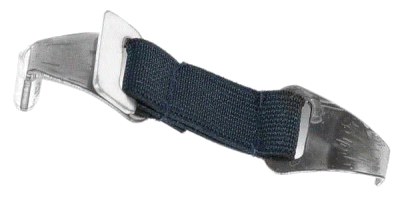
One of the most popular currently is called the "suspender capo." The end shown to the right hooks on at the edge of the neck closest to your toes. The end at the left (which has a protective vinyl wrap) comes around and clips on top of the fifth string behind whichever fret you need.
I have seen others that do more-or-less the same thing, including an all-plastic clip-on that I can't track down now (sorry about that).
The advantages are:
Disadvantages include:
- Unlike spikes or a sliding capo, it's one more thing to carry or to have to fish around for in your gig bag on a dark stage. Or for a friend to borrow and forget to return.
- They're not as fast as sliders, so if you are in a band that changes keys all the time quickly, you may find yourself fumbling with these while the rest of the band is plowing ahead in the new key.
- On most banjos, you have to take it off and set it somewhere you can get to it again if you need the fifth string to play in G. Which can make things awkward if it falls on the floor in a dark stage. :-)
However, if you just need one for rare instances, or if you generally don't change keys within songs, it's good thing to keep in your gig bag.
Over-the-Fret Slider Capos
A few more-or-less "home-grown" solutions that you can order work by slipping a shallow plug of some sort UNDER the fifth string, right on top of the fret. In a sense it's like moving the nut up the neck.
The simplest version in this class is just a triangular piece of rosewood with a perpendicular slot on the long side that centers it over the fret and a longitudinal slot in the peak that the fifth string goes through. Easy to pop on and off or slide up and down. Downside - it's easy to lose, and the fifth string isn't as bright as if it were passing over metal.
I used a drawing rather than a photograph of an actual product for sale because I'm not really in a position to recommend any specific product. There's no link to Amazon product for the same reason. (Note: One picker I know made one out of solid brass and it keeps the "fretting over metal" tone.)
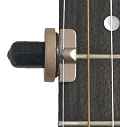
One over-the-fret capo has a slider that goes over the fret and a screw on the outside edge (parallel to the fifth-string tuner). It looks like it's made of brass and gets some great reviews, but some readers claim it's really mostly plastic, lightweight, and capable of popping out of place if you bump it. Most readers are surprised it costs as much as it does, even the ones who like it.
I didn't include an Amazon link of this class of product because I'm not in a position to recommend for or against it. Like all the other capos on this page, if you buy one online, be sure to check it out thoroughly the day it arrives in case it doesn't work like you think it should.
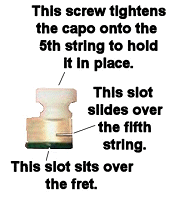 Another version looks like a little brass block with a slot for the fret, a slot for the string, and a vertical screw to tighten the capo to the string. The original was called the "Reagan," but that's no longer available so several copycats have come to take its place.
Another version looks like a little brass block with a slot for the fret, a slot for the string, and a vertical screw to tighten the capo to the string. The original was called the "Reagan," but that's no longer available so several copycats have come to take its place.
Advantages of over-the-fret slider capos include:
- No modification to your banjo required.
- Easily moved from one banjo to the next, as long as the action on both banjos is very close to the same.
- Generally low cost.
Disadvantages of over-the-fret slider capos include:
- Easily lost or misplaced.
- Except for rare exceptions, you can't keep it on your banjo when you need the fifth string to play in G - you have to take it off. (Having a stick-on holder for the thing, as one brand supplies, isn't really as convenient as they would like to make it sound.)
- Every one of these raise the fifth string a tad, which may or may not interfere with your right-hand playing. Some frailers complain that it does; most Bluegrass pickers don't mind.
- Most of these - even some with adjustment screws - depend on your fifth-string's action to be the same up and down the neck. Some won't even work on banjos with high action, unless you add felt or something to shim them up.
All that said, with one exception, the cost is pretty low to try out. Just make certain you try them out during the return window.
Home-Grown Solutions
A number of home-grown solutions have emerged, including- Many versions of the little wooden triangular slider.
- A wrap-around paper-clip solution that works best if you can slide insulation over the wire to keep it from scratching your banjo neck. Don't leave it on between sessions, or it will leave an indentation on the neck. No photos because I don't want to be responsible for you scratching up your banjo.
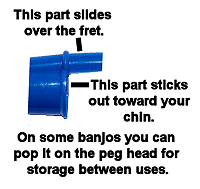
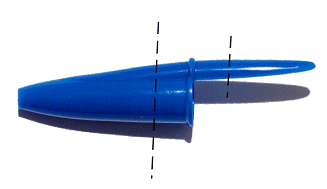 A Bic Pen solution, that involves sawing the pen top two places and sliding the part that remains over the fret.
A Bic Pen solution, that involves sawing the pen top two places and sliding the part that remains over the fret.
The photo doesn't show it, but the long "sticky-out" piece that you're supposed to use to keep your pen in your pocket protector has a little depression on the underside. That fits the frets on many banjos very well, and the pressure of the string keeps the capo in place.
Advantages include:
- Most home-grown solutions cost you next to nothing.
- You can keep experimenting until your capo works exactly how you need it to.
- Once you've figured out a solution that works for you, you can afford to make one for every 5-string you own.
Disadvantages include:
Still, what have you got to lose? :-)
"Spiking"
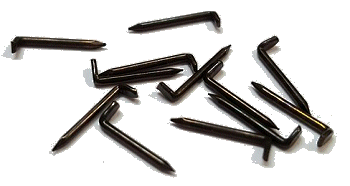 This is a modification that is becoming more popular all the time and is supplied automatically on some mid- and high-end banjos. It's called "spiking" because it started out using tiny "railroad spikes" that some HO model railroaders use when they fastened rails to wooden ties.
This is a modification that is becoming more popular all the time and is supplied automatically on some mid- and high-end banjos. It's called "spiking" because it started out using tiny "railroad spikes" that some HO model railroaders use when they fastened rails to wooden ties.
A tiny hole is predrilled in the fretboard and a "spike" is inserted just far enough that if you push or pull the spring underneath the "head," it will fret on the next highest fret. The following photo shows a spike that has been hand-installed by the Deering factory.

Some players like the open side of the spike to face their chin. Some players like it to face their toes. I prefer the former, since I almost always play the 5th string with my thumb. When the spike's opening faces down, I tend to pop the string out from under the spike head accidentally just through regular playing. For other folks with different picking styles, that doesn't seem to be a problem.
By the way, three of my Deering banjos came spiked with the spike opening facing toward my toes. On two of them, it was no trouble at all to use a needlenose pliers to pull them, turn them around, and reinsert them. On one that I got very used and cheap and largely rebuilt, a previous owner had tapped them all the way down so I had to finesse them up with a knife blade before I could do the same operation.
On banjos with dark fretboards, you can barely see them, so they're not as obtrusive as the sliders. The "spikes" cost hardly anything, since you can get dozens in a bag for a few dollars at a well-equipped model train store. Or buy a bag and split it with your friends, and your friends' friends, and so on.
The "down side" is that many people are afraid of drilling even very tiny holes in their banjos, and the truth is, it goes better if you have a drill press, and a very steady hand. Because the spike is so slim, you usually have to use a very tiny bit that will definitely not come in your ordinary "bit kit."
If you have a local luthier who doesn't say "huh?" when you ask him to spike your banjo, you might feel better paying him or her to do it. If he or she says "huh?" keep looking.
Most folks who "spike" banjos put the spikes at the 7th, 9th, and 10th fret. Which makes is easy to raise the G string to A, B, or C respectively. That supports playing in the keys of F, C, G, D, A, and E - more keys than most people ever play on a banjo.
To me, the fact that the spikes are almost invisible is a plus, because it keeps me from having to answer the same questions over and over, like I have to do with capos. They're also always there, so I don't have to go fumbling in my gig bag if the songleader suddenly yells out an unexpected key for the next song.
Also, I can engage or unengage the spikes with my left hand, even if I'm wearing fingerpicks. Something that folks struggle with on some capo types.
Advantages include:
- Always "onhand," almost impossible to lose, impossible to loan out to forgetful friends.
- Dirt cheap if you do it yourself.
- Easy to replace if you manage to pop one out (which almost never happens.)
- Work as designed every time, once they're installed correctly.
- Standard spiking arrangment (fret 7, 9, and 10) works for 99% of the songs you'll ever play on 5-string.
- Strings can be hooked or unhooked with the left hand even if you're wearing fingerpicks on the right.
Disadvantages include:
- You can't move your installation from banjo to banjo, so if you have multiple 5-strings, you might wind up spiking them all.
- You may be afraid of doing it yourself and you may have trouble finding someone to do it. (Hint: practice on your "beach banjo" first.)
- Some folks say the spikes get in their way when they're playing chords up the neck.
- You can't change keys as fast as you can with a rail-and-slider (Shubb-type) capo.
About Capos for the Other Four Strings
Though I use the spikes on my pro banjos all the time, I don't often use a capo for the other four strings, since I am usually just playing an accompaniment, and that's easy enough to do in E, A, D, G, or C without a capo.On the other hand, if I'm going to be playing a Bluegrass-style solo, and they insist on playing the song in A, I don't have much choice but to put a capo at the second fret and use G chords and picking patterns.
This can be anything that holds the strings down, from the old elastic ones to the modern clip-on ones. Though guitar capos can be used, capos made specifically for banjos' relatively narrow necks may be easier to into the right position quickly.
Octaves and Fifths, or Why High G Works in the Keys of C or G
Your fifth string will sound best when it's tuned to the "tonic" or the "fifth" of the key you're playing in. For example:- In the key of G, a high G note is the "tonic," the root note of a G scale (though an octave higher). It's:
- Part of the G chord - the "tonic"
- Part of the C chord - the "fifth," and
- The "Fourth" note in a D Suspended 7th chord.
Technically, a D7 chord should have an F#. But since there's already a G (coming from the fith string), banjo players playing in the key of G usually "cheat" and play a D7sus4 chord instead. What that really means is that the F# has been pushed up to a G. This isn't usually a problem in Folk, Americana, Bluegrass, or Country music.
- In the key of C, a high G note is the "fifth." That is, it's the fifth note of the C scale. It's:
- Part of the C chord - the "fifth",
- The "tonic" of a G or G7 chord, and
- The 9th of an F chord. No it doesn't quite fit in, but it doesn't clash too badly either.
Where to Capo the 5th string for Different Keys?
From the above examples, you can see that the fifth string usually gets along fine with the rest of the chords in a song as long as it's the tonic or the fifth of the song key. Here's a quick table that shows likely keys and what note the 5th-string could, technically, play. The "Preferred" column displays the notes that banjo players are most likely to tune the fifth string to for the song key dominating that row. The "Fret #" column shows what fret you would move your capo to if you were using a 5th-string capo. Note: If you're using a banjo that has been "spiked" at frets 7, 9, and 10, you can play a high Bb by using the spike for the 9th fret and tuning the 5th string down a half step.Key | 5th-string tuning | |||
(not fretted) |
||||
(not fretted) |
||||
Conclusion
If you have a starter banjo and you don't play out much or at all, you'd be safe using some of the inexpensive over-the-fret solutions, or making one yourself using a Bic pen lid some such.Folks who play out all the time tend to divide between:
- A rail-and-slider capo like the Schubb, or
- Spikes.
Yes, both require modification to your banjo (except for banjos that come with spikes from the factory). But trust me, if you drag your banjo out of the house night after night, you'll be modifying it plenty anyway, just not intentionally. Decide if you want to be a banjo player or collector, and the choice to add a modification that makes your life much, much easier won't be too hard.
Personally I prefer spikes. They're not obtrusive, they're easy to use, and the 7, 8, 10 arrangement works for every song I'm likely to play. (If I friend HAS to play a song in Bb, I can always spike the 5th string on the 7th fret and tune it down a half step.)
Though spiking is tending to "win out" over Schubb and similar capos in the overall market, some players whos bands change keys frequently, especially mid-song tend to go for the latter.
If you have anything to add to this page, or any corrections or complaints, feel free to contact me.
 Whatever else you get out of our pages, I hope you come away with some great ideas for "sharing the joy."
Whatever else you get out of our pages, I hope you come away with some great ideas for "sharing the joy."
And please stay in touch!
All material, illustrations, and content of this web site is copyrighted ? 2001, 2002, 2003, 2004, 2005, 2006,
2007, 2008, 2009, 2010, 2011, 2012, 2013, 2014, 2015, 2016, 2017 by Paul D. Race. All rights reserved.
Creek Dont' Rise(tm) is a participant in the Amazon Services LLC Associates Program, an affiliate advertising
program designed to provide a means for sites to earn advertising fees by advertising and linking to Amazon.com.
For questions, comments, suggestions, trouble reports, etc. about this page or this site, please contact us.
|
How To Help Us Promote Traditional Music for Free: If you find our tips, explanations, and recommendations helpful when picking out a product, and you appreciate that we don't continually inconvenience you with irrelevant ads or obnoxious popups, Please Bookmark This Page and come back through it when you're ready to order. In some cases - not all - we get a very small portion of your purchase price, all of which goes to supporting our sites. Ironically, if you don't come through our page, someone else like Facebook or the Weather Channel will usually get that "fee" anyway. In the meantime, it costs you nothing. We never see who placed the order, so you don't have to worry about us pestering you with followup e-mails or some such. But it helps us know what pages our readers find useful, and it helps our advertisers know who to support.
And that, in turn, helps us provide more useful resources. Thank you! |
| Visit related pages and affiliated sites: | |||||
| - Music - | |||||

|
 |
 |

|

|

|

|

|

|

|

|

|

|

|

|

|

|

|
| - Trains and Hobbies - | |||||
 |

|

|  |
 |

|
| - Christmas Memories and Collectibles - | |||||
 |

|
 |

|
 |

|
| - Family Activities and Crafts - | |||||
 |

|

|

|

|

|

